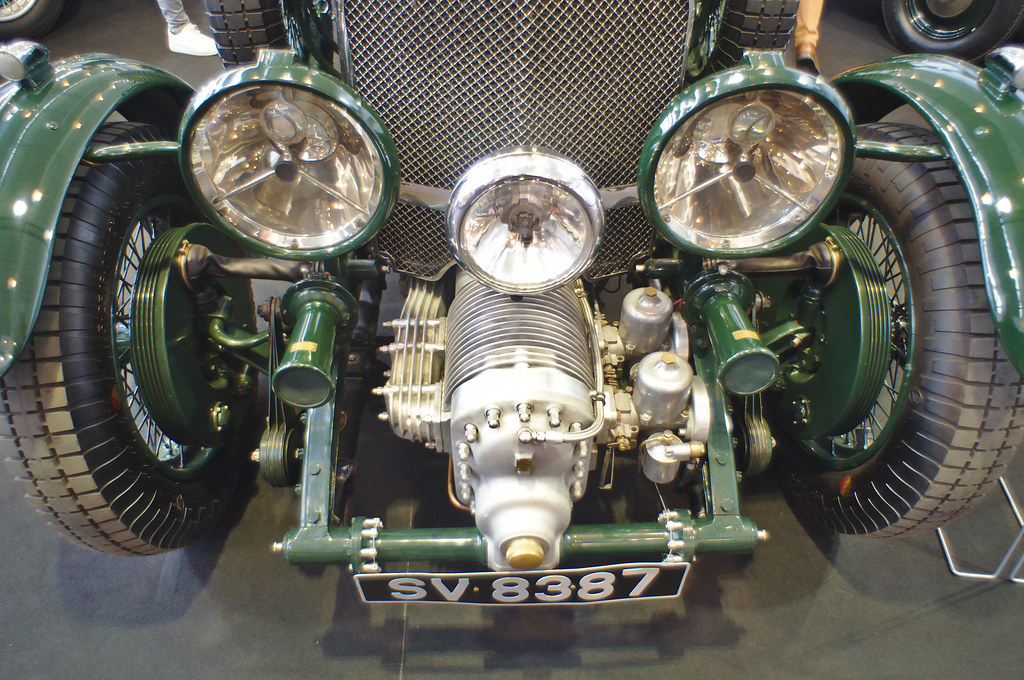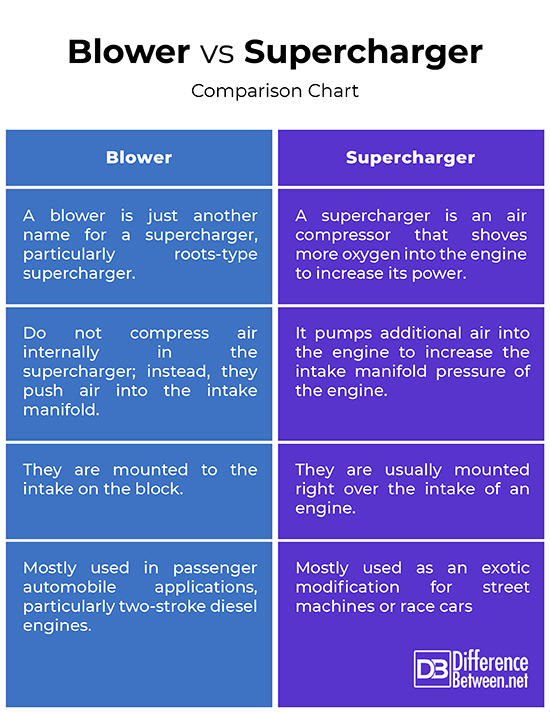Difference Between Blower and Supercharger
Before we jump right to the point, we need to understand how an internal combustion engine works technically. You probably think that engine in your car runs on gasoline and that’s it. Most of us do, but that’s not it. It runs on air, particularly expanding air. That’s what pushes the pistons and turns the crank. An electrical spark ignites the compressed air-gasoline mixture causing combustion and this blows the piston down the cylinder. The piston is connected to a crankshaft which the converts the up-and-down motion of the piston into rotary motion. The crankshaft then drives the rear wheels. So, the point is – the more air an internal combustion engine holds, the more power it makes. A supercharger increases the pressure or density of air that enters the engine to increase its efficiency and power. So, how is a supercharger any different than a blower? Let’s take a look.

What is Supercharger?
A supercharger is nothing but an air compressor that shoves more oxygen into the engine so they can make more power. It is like an air pump bolted onto the engine to increase the pressure or density of air supplied to the engine. It pumps additional air into the engine to increase the intake manifold pressure of the engine, and is driven mechanically via the belts that run off the crankshaft or by an electric motor. The air gets accelerated to high speeds and then slows down to increase the pressure. The air draws into an impeller where centrifugal force flings it out in compressor housing, where the speed is compressed in a high pressure instead, providing a significant increase in power without lag. So, in a nutshell, what a supercharger does is increase the amount of power that an engine produces by pumping air-fuel mixture (or air) into the engine at a rate that is beyond the force of atmospheric pressure. Superchargers are used as an exotic modification for street machines or race cars.

What is Blower?
Every blower is a supercharger, but not every supercharger can be a blower. A blower is just another name for a supercharger, particularly roots-type supercharger, which is probably one of the oldest styles of supercharger. At the heart of the roots-type supercharger are two counter-rotating meshed lobed rotors. The two spinning rotors trap air in the gaps between the lobes as they rotate, moving it around the outside of the rotors from the inlet at the top to the bottom of the supercharger. Technically speaking, roots-type superchargers do not actually compress air internally in the supercharger; instead, they push air into the intake manifold into the engine. That is why is type of supercharger is sometimes called a “blower” rather than a compressor. These types of superchargers used in cars typically have rotors with twisted lobes to ensure low vibration and quiet operation.
Difference between Blower and Supercharger
Device
– A supercharger is nothing but an air compressor device meant to increase the pressure pushing the air into the engine in order to increase its density, allowing the engine to have more oxygen-intake cycles. Superchargers are used as an exotic modification for street machines or race cars. A blower is just another name for a supercharger, particularly roots-type supercharger, which is probably among the oldest styles of supercharger.
Mechanics
– While the purpose of superchargers and blowers are basically the same – to pump air into the engine at a rate that is beyond the force of atmospheric pressure – superchargers are driven mechanically via the belts that run off the crankshaft or by an electric motor, while blowers use centrifugal force to push the air forward. Roots blowers do not actually compress air internally in the supercharger; instead, they push air into the intake manifold into the engine.
Working
– Superchargers are aimed at increasing the volumetric efficiency of the engine by producing a positive boost pressure in the engine manifold at some point in its operating range. Roots blowers count on the two counter-rotating meshed lobed rotors to create what is known as a positive displacement pump. The rotors are precisely synchronized with each other that maintain a narrow gap between the rotors at all times. The air gets trapped in the gap between the lobes as they rotate and then it’s passed down below it and forced into the engine.
Blower vs. Supercharger: Comparison Chart

Summary
Both blowers and superchargers are aimed at increasing the volumetric efficiency of the engine by pumping in additional air into the engine to increase the intake manifold pressure of the engine, thereby increasing its efficiency and power. Well, all blowers are superchargers, but not all superchargers are blowers. A blower is yet another name for superchargers, particularly roots-type superchargers, which are among the first superchargers to appear and probably the first that comes to mind when talking about superchargers generally.
- Difference Between Caucus and Primary - June 18, 2024
- Difference Between PPO and POS - May 30, 2024
- Difference Between RFID and NFC - May 28, 2024
Search DifferenceBetween.net :
Leave a Response
References :
[0]Ganahl, Pat. A Complete Guide to Street Supercharging. Minnesota, United States: CarTech, 2009. Print
[1]Hiereth, Hermann and Peter Prenninger. Charging the Internal Combustion Engine. New York, United States: Springer New York, 2007. Print
[2]Pettitt, Joe. Sport Compact Turbos & Blowers. Minnesota, United States: CarTech, 2004. Print
[3]Hartman, Jeff. Supercharging Performance Handbook. Minnesota, United States: Motorbooks, 2011. Print
[4]Image credit: https://commons.wikimedia.org/wiki/File:I1-variable-ratio-supercharger-cutaways.jpg
[5]Image credit: https://live.staticflickr.com/65535/47811250412_0b9b644680_b.jpg
